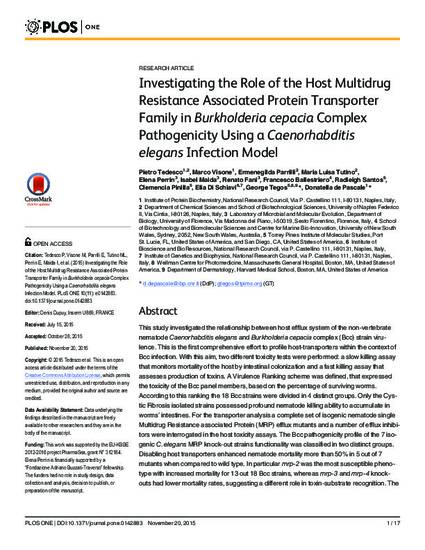
- Nematode infections,
- Caenorhabditis elegans,
- Death rates,
- Burkholderia cepacia complex,
- Gastrointestinal tract,
- Pathogenesis,
- Toxins,
- Cystic fibrosis
This study investigated the relationship between host efflux system of the non-vertebrate nematode Caenorhabditis elegans and Burkholderia cepacia complex (Bcc) strain virulence. This is the first comprehensive effort to profile host-transporters within the context of Bcc infection. With this aim, two different toxicity tests were performed: a slow killing assay that monitors mortality of the host by intestinal colonization and a fast killing assay that assesses production of toxins. A Virulence Ranking scheme was defined, that expressed the toxicity of the Bcc panel members, based on the percentage of surviving worms. According to this ranking the 18 Bcc strains were divided in 4 distinct groups. Only the Cystic Fibrosis isolated strains possessed profound nematode killing ability to accumulate in worms’ intestines. For the transporter analysis a complete set of isogenic nematode single Multidrug Resistance associated Protein (MRP) efflux mutants and a number of efflux inhibitors were interrogated in the host toxicity assays. The Bcc pathogenicity profile of the 7 isogenic C. elegans MRP knock-out strains functionality was classified in two distinct groups. Disabling host transporters enhanced nematode mortality more than 50% in 5 out of 7 mutants when compared to wild type. In particular mrp-2 was the most susceptible phenotype with increased mortality for 13 out 18 Bcc strains, whereas mrp-3 and mrp-4 knock-outs had lower mortality rates, suggesting a different role in toxin-substrate recognition. The use of MRP efflux inhibitors in the assays resulted in substantially increased (>40% on average) mortality of wild-type worms.
Available at: http://works.bepress.com/radleigh-santos/26/

Copyright: © 2015 Tedesco et al.
This is an open access article distributed under the terms of the Creative Commons Attribution License, which permits unrestricted use, distribution, and reproduction in any medium, provided the original author and source are credited.